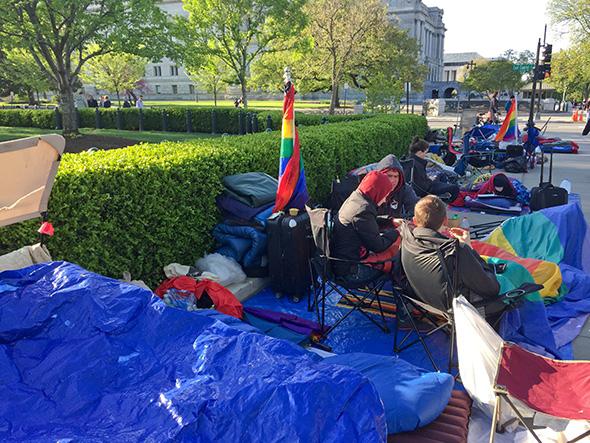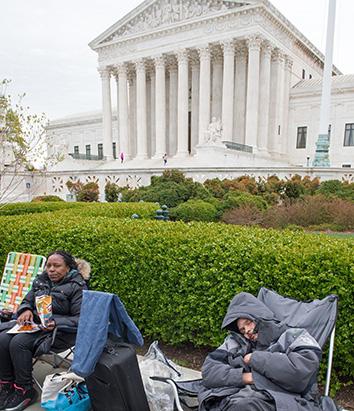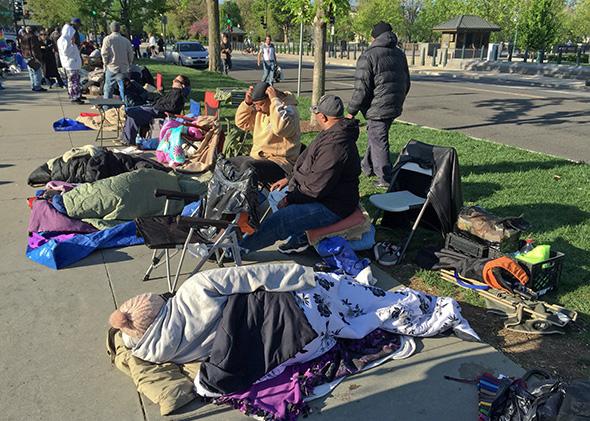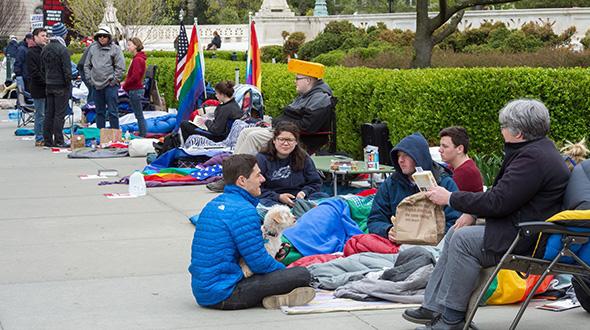As you may have heard, this week the U.S. Supreme Court will hear arguments in a group of same-sex marriage cases massed under the name of Obergefell v. Hodges. For many Americans, the arguments in the marriage equality cases will be the most important inflection of the court into the very core of their homes, their lives, and the status of their families. Many of those Americans started lining up Friday, four days before arguments that will take place on Tuesday morning, for a chance to witness one of the most important moments in Supreme Court history.
Many other Americans simply paid a line-standing service $50 an hour to secure a place for them.
Starting Friday, if you or your law firm had $6,000 to shell out, a paid proxy—a company such as LineStanding.com or Washington Express—would arrange to have someone hold your place in line. The fact that some of these line-standers appear to be either very poor or homeless and may have to stand in rain, snow, sleet, or hail so that you don’t have to irks at least some people who feel that thousands of dollars shouldn’t be the fee to bear witness to “Equal Justice Under the Law”—the words etched over the door to the Supreme Court building—in action.

Photo by Mark Joseph Stern
As former Rep. Barney Frank, Democrat of Massachusetts, told the Caucus blog two years ago, the problem of wealthy lawyers paying poor people to suffer in the cold on their behalf would be remedied almost instantly if the court would allow its hearings to be televised.
The Supreme Court chamber is tiny. As Adam Liptak pointed out in 2013:
There are about 400 seats in the courtroom, but many of them are set aside for guests of the justices and for the news media. For the first argument, there were 105 seats available for members of the bar and about 70 for the public, said Kathleen Arberg, the court’s public information officer. On the next day, there were 78 seats for members of the bar and about 70 for the public. Another 30 seats each day were set aside for people who rotated through for a three- to five-minute glimpse of an argument.
What all that means in practice is that there is seating for some (but not all) of the journalists who want to cover the case, and seating for some (but not all) intimates of the justices who want to watch history in the making, and also seats for many (but not nearly all) of the members of the Supreme Court Bar who would like to witness arguments in the gay marriage cases, but there are, give or take, 70 seats for the entire rest of America. These are the folks who get to stand in line (some began queuing up for the 2012 Obamacare case three days ahead of time). Or to pay someone else to do it for them.

Photo by Paul J. Richards/AFP/Getty Images
What this limited seating means in a case like Obergefell is astonishing. Carisa Cunningham, director of public affairs and education for Gay & Lesbian Advocates & Defenders, which will be arguing part of the case, notes that “people who worked on the cases (including lawyers), and even parents and children of plaintiffs, and even plaintiffs themselves” may not be able to get into court Tuesday. A good many of them will be left to stand outside the building.
On Monday morning, we trekked down to the court to witness the line-standing in action, when 67 people were waiting in line. None of the first 15 people in line would speak to us, on or off the record. Matthew Skinner, the executive director of the LGBT Bar Association of Greater New York, was 47th in line, and he had waited there since Sunday evening. He estimated that a significant majority of line-standers were hired by a professional line-standing company and were instructed not to say anything to reporters. He pointed them out, and we attempted to speak to them. All of them told us the same thing: “No comment.” Evidently, this is not the sort of arrangement one brags about.
Another woman who had waited in line since Friday told us the existence of professional line-standers was “an open secret” and that none of them would acknowledge that they were being paid to hold a spot. Those who were waiting in line for themselves seemed to both resent and pity the professional line-standers. A woman who had waited since Sunday told us she was disgusted by how “racialized” the line-standing process was.
“Let’s pay the poor black guys to hold the line for the rich white people,” she said.

Photo by Mark Joseph Stern
Many have argued the process would be more fair, or at least look less like a feudal wedding banquet, if the Supreme Court were to allocate seating based on a lottery. Of course the simplest and fairest solution to this mess would be to allow cameras into the court, but there is not much point in holding out any hope for that. So instead we stand in the rain and wait. Or pay others to do so instead.
Sometimes when the justices talk about why they have chosen to bar all cameras from the courtroom, they claim that the hoi polloi just aren’t savvy enough to fully appreciate how complicated oral argument can be. Sonia Sotomayor, normally the court’s populist, told Charlie Rose in 2013 that she opposed cameras at the high court because, “I don’t think most viewers take the time to actually delve into either the briefs or the legal arguments to appreciate what the court is doing,” she said. “They speculate about, oh, the judge favors this point rather than that point. Very few of them understand what the process is, which is to play devil’s advocate.” The New York Times’ Liptak described that attitude as an “intellectual poll tax.” Justice Antonin Scalia famously said that the complexity of the law “is why the University of Chicago Law Review is not sold at the 7-Eleven.”
More and more, the court’s access policy for days with big cases suggests that these kinds of arguments aren’t just reasons to bar cameras from the court; they’re also looking a lot like arguments for limiting the number of regular folks who can attend. Sadly, the current setup sends precisely the wrong signal: The court doesn’t belong to the people. It belongs to the people who pay the other people to stand in the rain and say, “No comment.”
Read more of Slate’s coverage of gay marriage at the Supreme Court.
